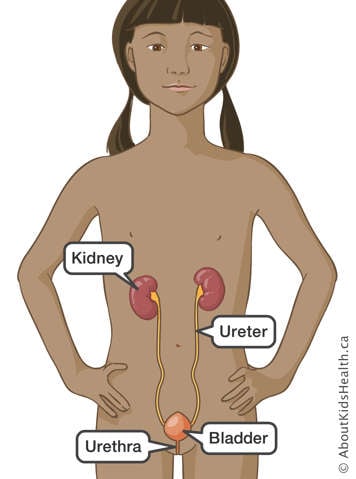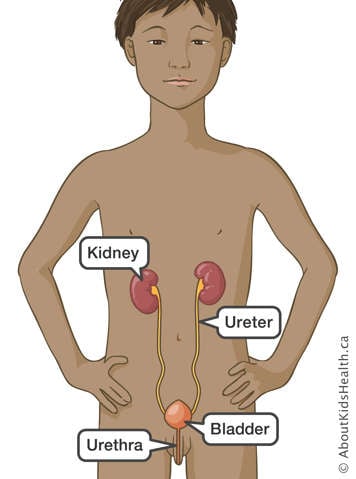
What is a VCUG?
A VCUG is a special test that uses X-rays to show what happens when your child urinates (pees).
VCUG is short for voiding cystourethrogram. Voiding means urinating. Cysto stands for the bladder. Urethro stands for the urethra, the tube that empties urine from the bladder. Gram means the picture. So the VCUG is a picture of the urine moving from the bladder and out through the urethra.
The test uses a special liquid called contrast medium to make the urine show up better on the X-ray.

Preparing your child for the test
Take time to read this information carefully and explain it to your child. Children who know what to expect are usually less anxious. Explain the test in words you know your child will understand, including the words your family uses to describe how the body works.
As part of the test, a small tube called a catheter will be placed in your child's urethra. Placing the catheter will be uncomfortable. But your child will find it more comfortable if they can relax. You can help your child relax by teaching them to take slow deep breaths. Have your child pretend to blow out birthday candles, blow up a balloon or blow bubbles. Practise this breathing exercise at home before you come to the hospital.
Young children sometimes want to bring something comfortable to hold during the test. Your child may want to bring a stuffed toy or a blanket from home.
One parent can be with the child at all times during the test. If you are pregnant, you can stay in the room while the catheter is being placed. But you must leave the room when your child has the X-ray.
You may want to explain to your child that the doctors or technologists will need to touch your child's private parts to clean them and to place the catheter. Explain to your child that you have given them permission to touch them because the test will help the child.
Two technologists will perform the test
The technologists are specially trained to place the catheter and to take the X-rays. Sometimes the radiologist must also be in the room during the test. The radiologist reads the X-ray.
The X-ray technologist will prepare your child for the test by explaining what will happen. The technologist will carefully wash your child's penis or the opening to the urethra. Then the technologist will place a bendable catheter into the opening. The catheter is a long, thin, soft tube that goes through the urethra to the bladder. The technologist will explain each step as they do it.
If your child has a heart condition
Your child may need to take antibiotics before having any test or treatment. For example, children with heart conditions need to take antibiotics before going to the dentist. An antibiotic is a medicine that kills infection. If your child needs this medicine, please tell the doctor who wants your child to have a VCUG. The doctor will get this medicine for your child before they have the VCUG.
VCUGs are usually done at the hospital
VCUGs are done in the Department of Diagnostic Imaging, often called the X-ray department. If you are unsure about the location of the department, ask at the main reception.
The test takes between 20 and 30 minutes. After the test, you will need to stay in the department for about 15 minutes while the images are prepared.
During the test
After you check into the Department of Diagnostic Imaging, your child will change into a hospital gown in one of the change rooms. Then your child will be taken into the X-ray room. Only one parent can go with the child.
In the X-ray room
Once you and your child are in the X-ray room, the technologist will ask you to remove your child's underwear or diaper. Then your child will lie on an X-ray table. A safety band may be placed across your child's stomach or legs to make sure your child is safe.
A camera above the table will take the pictures. The technologist will use a television screen to see what is happening during the test.
To get the best results, your child must lie as still as possible while the technologist takes the X-rays. You can help your child by holding hands gently up by your child's chest and by keeping your child's attention any way you can. For example, you could read or sing.
Placing the catheter
The X-ray technologist will begin the test by cleaning your child's private parts and placing the catheter. The catheter will make the bladder empty by itself.
The catheter will then be connected by a tube to a bottle filled with contrast medium. This contrast medium flows through the tube into the bladder. It lets the technologist get a better view of the inside of the bladder and urethra. Your child may feel the contrast as it goes through the bladder. It may feel cool, but it will not feel uncomfortable.
While the contrast medium is flowing into the bladder, the X-ray technologist will take some X-rays. When your child's bladder is full, your child will be asked to urinate into a bedpan or diaper. The catheter will come out easily by itself as your child urinates. The technologist will take some X-rays while your child is urinating. These are the most important pictures of the test.
Once your child has finished urinating and the pictures have been taken, the test is finished. The X-ray technologist will help your child off the table and make sure that they are clean and dry.
After the test is done
The X-ray technologist will tell you how to get to the change room where your child can change into their own clothes. Then you can have a seat in the waiting room. The technologist will let you know when you can leave after the X-ray images have been checked.
If you have an appointment in the clinic to see the doctor after the test, please tell the technologist. They will make sure your results are sent to the clinic. If you are not seeing the doctor after the test, the results will be sent to your child's doctor within a week.
Give your child lots of clear fluids at home
Your child may feel some discomfort, such as a burning feeling, when urinating for the first few times after the test. Over the next day or so, give your child lots of clear liquids such as water or apple juice. Drinking clear liquids will help ease any discomfort your child may have.
If you have any questions about the effects of the test, please ask the technologist. If your child is uncomfortable for more than 24 hours, call your family doctor.
At SickKids
VCUGs are done in the Department of Diagnostic Imaging, often called the X-ray department. This department is on the second floor in the Elm Street Wing in the older part of the hospital.
Please check in with the receptionist at the desk called the GI/GU Patient Check In. You will find this desk beside the Elm Wing elevators on the second floor.
If you need to cancel your child's test, please call 416-813-6068 as soon as possible. We need to give your child's appointment to another child on our waiting list. There is a long waiting list for these tests.